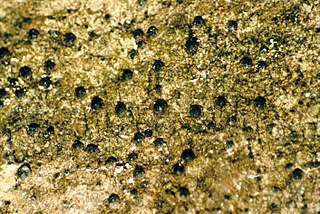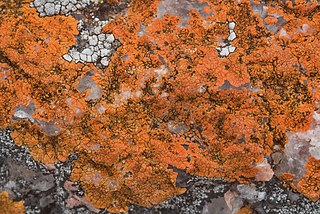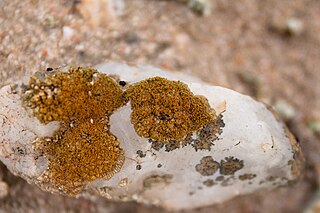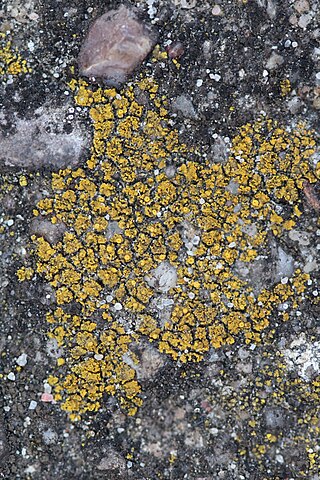
The Lecanoraceae are a family of lichenized fungi in the order Lecanorales. Species of this family have a widespread distribution.

The Teloschistaceae are a large family of mostly lichen-forming fungi belonging to the class Lecanoromycetes in the division Ascomycota. The family has a cosmopolitan distribution, although its members occur predominantly in temperate regions. Most members are lichens that either live on rock or on bark, but about 40 species are lichenicolous – meaning they are non-lichenised fungi that live on other lichens. Many members of the Teloschistaceae are readily identifiable by their vibrant orange to yellow hue, a result of their frequent anthraquinone content. The presence of these anthraquinone pigments, which confer protection from ultraviolet light, enabled this group to expand from shaded forest habitats to harsher environmental conditions of sunny and arid ecosystems during the Late Cretaceous.

The Baeomycetales are an order of mostly lichen-forming fungi in the subclass Ostropomycetidae, in the class Lecanoromycetes. It contains 8 families, 33 genera and about 170 species. As a result of molecular phylogenetics research published in the late 2010s, several orders were folded into the Baeomycetales, resulting in a substantial increase in the number of taxa.
Josef Hafellner is an Austrian mycologist and lichenologist. He was awarded the Acharius Medal in 2016 for his lifetime contributions to lichenology. Before his retirement, he was a professor at the Karl-Franzens-Universität in Graz. Hafellner started developing an interest in lichens while he was a student at this institution, studying under Josef Poelt. He earned a master's degree in 1975 and a PhD in 1978, defending a doctoral thesis about the genus Karschia. In 2003, Hafellner received his habilitation. By this time, he had studied with French lichenologist André Bellemère (1927–2014) at Saint-Cloud, where he learned techniques of transmission electron microscopy and how their application in studying asci could be used in lichen systematics. His 1984 work Studien in Richtung einer natürlicheren Gliederung der Sammelfamilien Lecanoraceae und Lecideaceae has been described as "probably the single most influential publication in lichen systematics in the latter half of the 20th century".

Gyalolechia is a genus of lichen-forming fungi belonging to the family Teloschistaceae. It contains 18 species of crustose lichens.

Arthrorhaphis is a genus of lichen-forming fungi in the monotypic family Arthrorhaphidaceae. It has 13 species. The genus was circumscribed by Theodor Magnus Fries in 1860. The family was proposed by lichenologists Josef Poelt and Josef Hafellner in 1976. Species in this family have a widespread distribution in temperate and montane habitats. They grow symbiotically with green algae, or parasitically on other lichens. The family Arthrorhaphidaceae has an uncertain taxonomic placement in the class Lecanoromycetes; that is, it is incertae sedis with respect to ordinal placement.

Scoliciosporum is a genus of lichens in the family Scoliciosporaceae.
Apatoplaca is a fungal genus in the family Teloschistaceae. It is monotypic, containing a single species, the rare crustose lichen Apatoplaca oblongula, found in the United States.
Gallowayella aphrodites is a species of corticolous (bark-dwelling), foliose (leafy) lichen in the family Teloschistaceae. It is found in the Mediterranean countries Greece, Cyprus, and Italy. Characteristics of the lichen include its small thallus, the disposition of the rhizines on the thallus undersurface, and the lack of vegetative propagules.

Wetmoreana appressa is a species of saxicolous (rock-dwelling), crustose lichen in the family Teloschistaceae. It has a widespread distribution in western Mexico, including Baja California. It is characterized by its vibrant colors, unique shape, and specific habitat preferences.

Stellarangia namibensis is a species of saxicolous (rock-dwelling), crustose lichen in the family Teloschistaceae. It was first formally described in 1988 by Ingvar Kärnefelt, as a member of the genus Caloplaca. The type specimen was collected by the author from the gravel flats east of Cape Cross, in Omaruru, Namibia. The same species was collected from Angola by Austrian botanist Friedrich Welwitsch in 1859. The taxon was transferred to the genus Stellarangia in 2013 by Ulrik Søchting and colleagues, as part of a molecular phylogenetics-based restructuring of the Teloschistaceae.
Calogaya alaskensis is a species of crustose lichen in the family Teloschistaceae. It was first described as new to science in 2004 by Clifford Wetmore, who placed it in the genus Caloplaca. Ulf Arup and colleagues transferred the taxon to Calogaya in 2013 following a molecular phylogenetics-led restructuring of the Teloschistaceae.

Squamulea squamosa is a species of saxicolous (rock-dwelling), squamulose lichen in the family Teloschistaceae. Found in southwestern North America, it was first formally described by Maurice Bouly de Lesdain in 1933, as Placodium squamosum. Alexander Zahlbruckner proposed a transfer to genus Caloplaca in 1940, and the lichen was known as a member of that genus for more than seven decades. Ulf Arup and colleagues transferred the taxon to the genus Squamulea in 2013, following a molecular phylogenetics-based restructuring of the family Teloschistaceae.

Flavoplaca arcis is a species of saxicolous (rock-dwelling), crustose to squamulose (scaley) lichen in the family Teloschistaceae. Although widely distributed in Northern, Central, and Western Europe, it is not commonly encountered.
Caloplaca filsonii is a species of corticolous (bark-dwelling), crustose lichen in the family Teloschistaceae. It has a crust-like thallus that is uneven and warty around the edges and more distinctly wart-like in the centre, coloured in shades of grey and brownish-grey near its reproductive structures (apothecia), but lacking a developed prothallus.
Pyrenodesmia micromontana is a species of saxicolous (rock-dwelling), crustose lichen in the family Teloschistaceae. Found in the Orenburg region of Russia, this species prefers to grow on lime-rich schist and sandstone boulders and pebbles in scrubs and steppes.

Flavoplaca limonia is a species of saxicolous (rock-dwelling), crustose lichen in the family Teloschistaceae. It was first formally described as a new species in 1994 by lichenologists Pier Luigi Nimis and Josef Poelt. Ulf Arup and colleagues transferred the taxon to the genus Flavoplaca in 2013, following a molecular phylogenetics-based restructuring of the family Teloschistaceae.
Austroplaca soropelta is a species of saxicolous and muscicolous, crustose lichen in the family Teloschistaceae. It has a bipolar distribution, meaning it occurs in polar areas of both the Northern and Southern Hemispheres.
Teloschistopsis bonae-spei is a species of saxicolous (rock-dwelling), fruticose lichen in the family Teloschistaceae. It occurs in South Africa, where it grows on maritime and coastal rocks.










